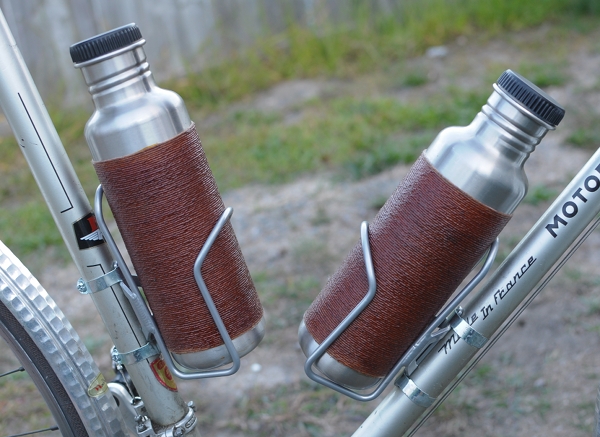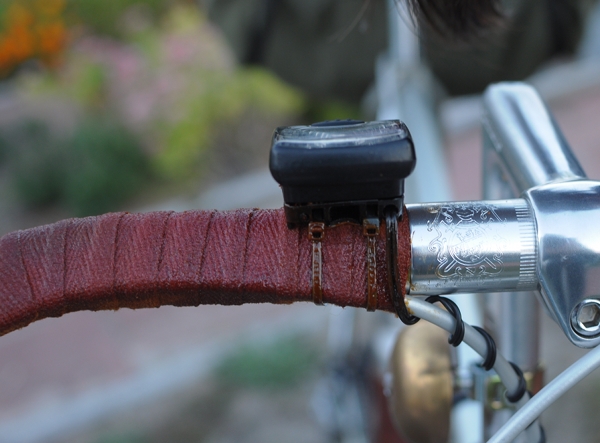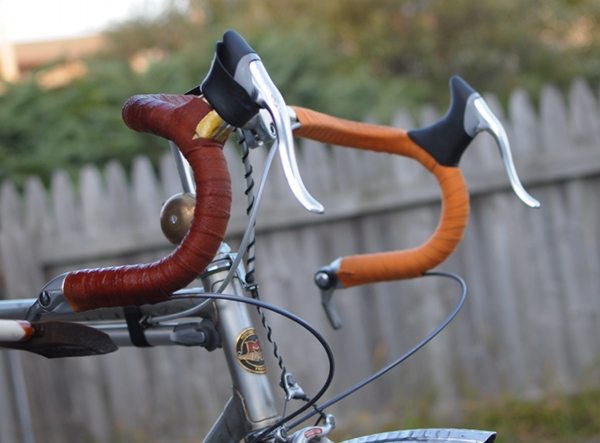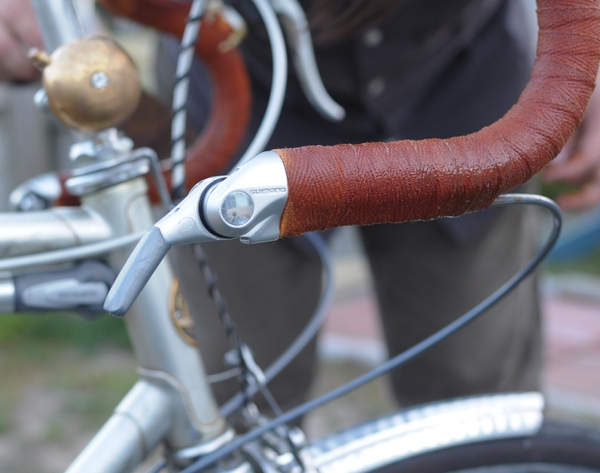With the rise of the "classic bicycle aesthetic" it is becoming increasingly popular again to shellac handlebar tape, cork grips and twine. Obviously I love the trend. But I also think that people ought to be aware that the purpose of shellacking is predominantly practical, not aesthetic.
Shellac is an all-natural natural sealant (derived from the secretions of a Thai insect), which makes it perfect for waterproofing wood and cloth. When you cover your handlebars in cloth tape, two things will happen to them over a surprisingly short time period: They will get dirty from your hands rubbing road dust into them, and they will get soggy from rain and sweat - which can cause the tape to distend, discolour, and even rot eventually. Shellac will form a protective layer that will prevent this from happening.
At this point, we have applied shellac so often and to so many bicycles, that we have gone through 3 cans of the stuff in a year and a half. For those interested, here is how I like to do it:
. I use a 1" foam brush, rather than a real paintbrush. A paintbrush can leave visible brush strokes, whereas a foam brush makes it easy to quickly put down an even coat. Also, because shellac is difficult to wash out, it is pretty much a given that you will ruin paintbrushes with it. Ruining a foam brush is less costly.
. I like to apply shellac in thin layers, rather than oversaturating. This way it dries faster, and I have better control over the thickness.
. Because I like to feel the texture of my bar tape, I am careful not to go overboard with the shellac application. If you apply so much that your bars feel glassy and hard as a rock, they might not be so comfortable to hold. If you find that you've accidentally done this, try going over it with steel wool or fine grade sandpaper to restore some of the texture.
. Since I ride my bike often and in bad weather, I re-shellac on a fairly regular basis. The shellac tends to wear off first in the spots where I keep my hands the most. When I notice this, I know it is time to add another thin layer.
. Shellacking the night before I plan to ride the bike usually leaves sufficient drying time - but doing it at least 24 hours beforehand is safer. Once or twice, I've ended up holding my hands on the hoods during an entire ride, because the bars were still not 100% dry.
Twine requires shellacking for similar reasons as bar tape: If left in its natural state, it will unravel over a short time period from friction and moisture.
Because of their distinct look, it is understandable that shellacked tape or twine on a bicycle can be seen as a fashion statement. But while I am happy it looks nice, for me the practical benefits far outweigh this aspect. If it were not for shellac, I would destroy my cloth tape on a regular basis. And in case you are wondering - Yes, of course we brought shellac to the Cape! The Co-Habitant has finally replaced his Motobecane's stem shifters with Shimano bar-ends, and we re-did his tape as the sun was setting over the beach next to our house.
Wednesday, September 15, 2010
Subscribe to:
Post Comments (Atom)
Blog Archive
-
▼
2010
(1788)
-
▼
September
(58)
- Enclosed rockers, springs and double camshafts
- Ice White Brutale!
- Fog Lights
- 1932 Norton M40 Internationals - For Sale
- Bennett's 1925 TT Norton again
- Lovely Dress Guards Give-Away
- Max's 1931 Model 20 Norton
- Do You Cycle When You're Sick?
- It's a Gale indicator!
- Twelve men and a Norton
- Car Talk... Recollections of a Wilted Romance
- Making an Ordinary Vintage Roadbike Extraordinary ...
- MINI Scooter E Concept's unveiled
- His and Hers Bicycles: Matching Looks vs Matching ...
- Viktor's 1927 Model 18 Norton
- Hard Core Bicycle DIY: Is It Worth It?
- Improvements in the valve mechanism of internal co...
- Mobile Home
- Removing the pinion from the crankshaft
- Faithfull Traveling Companions
- Salvaging Style with Hats, Scarves and Argyle
- R J D Burnie's Nortons
- XINGYUE Recalls 2009-2010 Auto Moto XY150ZK Motor ...
- Full Fat Cream! In Love with My Grand Bois Hetre T...
- Stanley Woods and a 1928 CS1 Norton
- Car Free, Skirt Free and Exhausted!
- T.T Toffee again!
- Shellac: Why and How?
- Celeb model gets soapy with Bennetts Babes in Biki...
- Kawasaki unveil Z750R
- Bennett's 1925 TT Norton again
- Happy Trails! Tips for Long Rides
- 1925 Model 18 Norton
- Motorcycle Cannonball Endurance Run - Old Bikes Hi...
- For sale: 1929 Norton Model 16H
- Turn Your Capris into Cycling Knickers
- The Allure of the Handlebar Bag
- Motorcycle Pictures of the Week - Ken & Lynn
- Sturmey Archer gearboxes fitted to Vintage Nortons
- What Is a Girl to Ride?
- Motorcycle Accidents - Save Yourself
- Maybe Next Year
- Front Racks and Elegant Light Placement: Mission I...
- For sale: c1925 Norton Model 18
- Geoff's 1925 Big Four Norton
- Cork It or Cloth It?
- 1922 Model 9 Norton
- Strange Magic! And a Saddle Conundrum
- Crime vs. Accident?
- Motorcycle Pictures of the Week - Jose
- Bike modification for new look of your bike
- Bike modification for new look of your bike
- Ducati 749R, World Supersport Motorcycle
- Ducati 749R, World Supersport Motorcycle
- The ??? Bennett bike!
- French Experiments Continue: Belleville Handlebars...
- c1935 ES2 Norton
- Velo Orange Croissant Bag: Small, Tidy, Classic
-
▼
September
(58)





0 comments:
Post a Comment